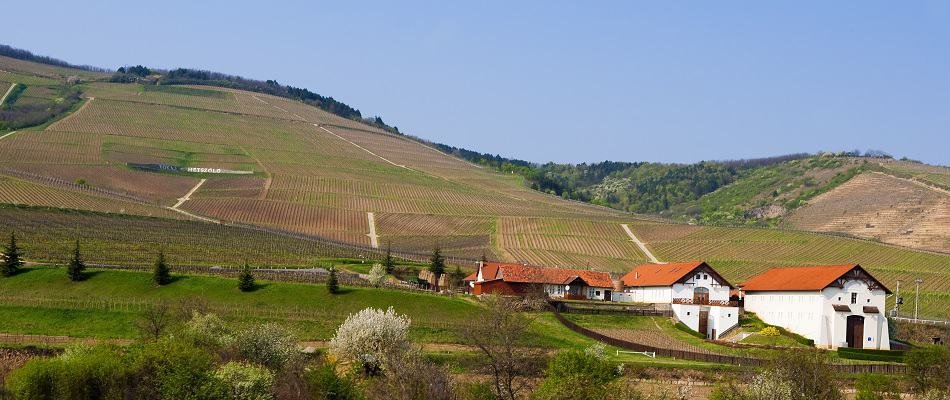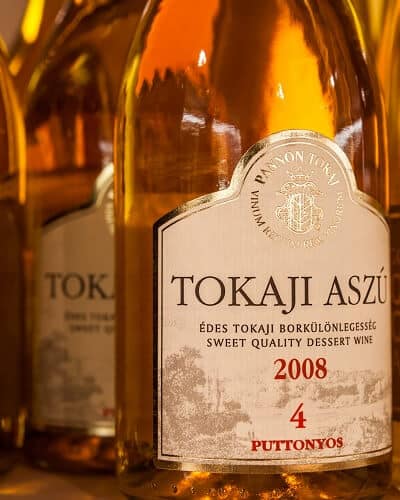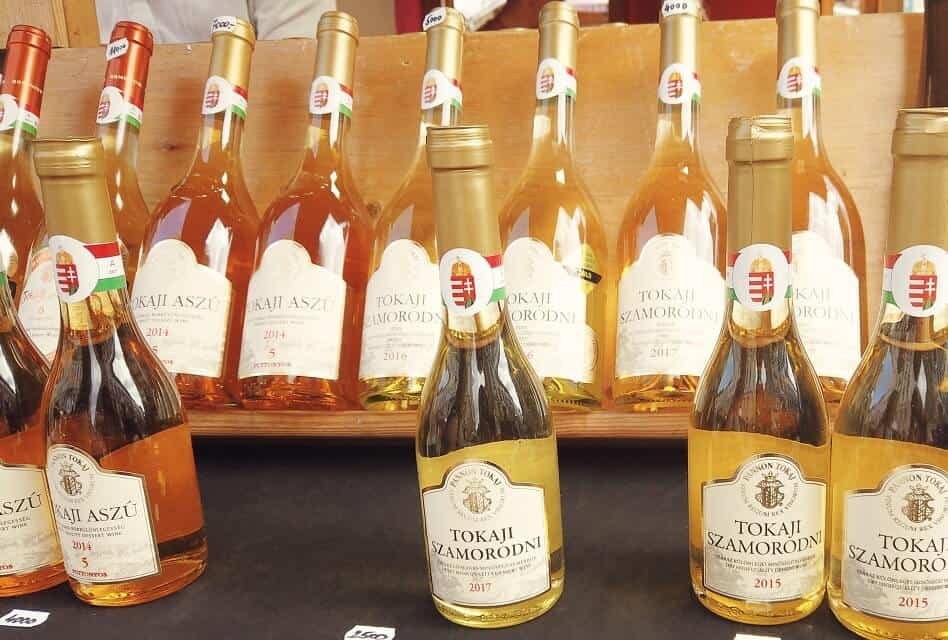Tokaji is a white wine from Hungary with a tradition of hundreds of years. It can be dry, but the most famous types are sweet dessert wines. The best of these wines are made from noble rot grapes that vintners let intentionally dry on the vines.
In this article, we will discuss the different types of Tokaji, how they are made, and how they taste in detail.
WHERE IS TOKAJI WINE FROM?
Tokaji wines come from the Tokaj region, also known as Tokaj-Hegyalja (English: Tokaj Foothills) in North-East Hungary. It’s one of the country’s seven wine regions and contains more than 11,000 hectares (27,000 acres) of vineyards. A small portion of the area is located in Slovakia.

Tokaj Wine Region, Hungary
Another interesting feature of the region is its extensive system of cellars. It had existed since the 15th century when locals carved it into the rocky grounds. The cellars are home to a specific type of mold that feeds from vaporizing alcohol. It creates a constant humidity level of around 90%, just perfect for storing and maturing Tokaji wines.
The History of Tokaj Wines
The Tokaj region has a long history of winemaking. Historians claim that it started in the times of the Roman empire around 300 AD. Over the centuries, many different cultures immigrated into the region. Among them were the Slavs in the 6th century, the Magyars in the 9th century, and the Walloons between 1100 and 1300 AD. All of them were engaged in winemaking, but the region’s rise to fame only started in the 1600s.
A major factor in this rise was sweet Tokaji wine. A Hungarian legend attributed its invention to the invasion of the Turks in the early 17th century. Their attack forced the local landowners to postpone the wine harvest. When they finally could start, they realized that the grapes were infected with noble rot and dried out on the vines. Nevertheless, they brought them in and proceeded to them into wine that turned out to be deliciously sweet.
It is disputed whether this legend is true because historical evidence suggests that noble rot wines existed decades before the described event. However, Tokaj’s winemakers started exposing their wines to the fungus that causes noble rot intentionally. And the sweet wine they made became very popular in all of Hungary. It also became one of the most important export goods for the princes of Transylvania who ruled over the region. Especially the high society of Poland and Russia bought it regularly. The Russian Emperor even established a representation in the Tokaj region to ensure the wine supply did not run dry. Another famous fan of Tokaji wines was King Louis XIV of France.
In 1737, a royal decree delimited the Tokaj region and set strict regulations for wine production therein. Forty-five years later, one of the world’s first classification systems with precise quality standards was introduced.
By the end of the 18th century, a series of setbacks reduced the region’s wine output significantly:
- First, Poland was annexed and partitioned by Russia, Prussia, and Austria. As the conquerors imposed significant customs on imported goods, exports from Tokaj to Poland declined significantly.
- Second, an insect epidemic infected and destroyed most of the region’s vineyards in 1885.
- Third, the Kingdom of Hungary lost World War I to the allied forces led by Russia, France, and Great Britain. According to the Treaty of Trianon in 1920, Hungary lost big portions of its territory, including the Northern part of Tokaj. Since then, this area has belonged to Czechoslovakia and, after the country split up, to Slovakia. For this reason, a small part of Slovakia still is part of the official Tokaj wine region.
- Fourth, after World War II, the communist regime led to a further decrease in wine quality and the region’s reputation.
Tokaji Wines in Modern Days
The end of the communist rule in 1989 paved the way for a new rise of Tokaji wines. Investors, particularly from France, modernized existing wineries, implemented modern winemaking technology and founded new companies. Today, almost 600 wineries operate in Tokaj, and on average, they produce around 180,000 hectoliters of wine per year.
Due to its history, UNESCO recognized the region as a World Heritage Site in 2002. This status protects the vineyards, the more than 3,000 wine cellars, and the Tokaji museums.
WHAT IS TOKAJI WINE MADE FROM?
Vintners may use six white varietals to make Tokaji wine:
- Furmint
- Hárslevelű
- Kabar
- Kövérszőlő
- Yellow Muscat
- Zéta
Furmint is the most important grape variety among them. Around 60% of the region’s plantings are Furmint grapes that grow on small plateaus on the mountain foothills. They are high in acidity and tannins, and as they ripen late in the year, they can accumulate a lot of sugar. The thick-skinned berries grow in loose bunches, making them prone to pests but also the desirable noble rot.
While ripening, the grapes’ skins become thinner, allowing the sun to evaporate their liquids. As a result, the grape sugar concentrates on the remaining juice that gets very sweet.
Is Tokaji A Fortified Wine?
No. Unlike producers of other dessert wines like Port, Madeira, or Lillet, Tokaji vintners don’t fortify their wines with spirits. Therefore, their alcohol content typically isn’t higher than 15%.
HOW THE DIFFERENT TYPES OF TOKAJI WINE ARE MADE
Tokaji wines come in various styles that differ primarily in sweetness. Depending on which style vintners want to make, they follow different production processes.
How Tokaji Aszú Is Made
Tokaji Aszú is the best-known variation that made the Tokaj region famous. It is a golden-colored, highly concentrated noble rot wine.
To make Aszú wines, vintners let grapes stay on the vines until noble rot infects them. This fungus covers the berries with a thin dust-like coat and dehydrates them. The grapes shrivel and dry out until they look similar to raisins. When harvested, they have only a little bit of juice left over. But as all of their sugar accumulates in this juice, it is incredibly sweet.
Vintners cannot infect the grapes directly with noble rot, though. They can only create circumstances that promote its natural occurrence. Whether noble rot actually dries out the grapes depends on the weather. So in years with unfavorable weather conditions, winemakers cannot produce Aszú wine.
To ensure that only properly dried grapes make it into the wine, vintners select and harvest them by hand. Commonly, they do multiple rounds of manual harvesting to gather enough berries for their precious wines.
Then, they mash them into a paste called “Aszú dough” and add a dry base wine to macerate it for up to five days. Next, the workers press the mixture and ferment the resulting juice. Afterward, they age it for at least two years in barrels in one of the region’s numerous cellars.
How Aszú Eszencia Is Made
Like Aszú, Aszú Eszencia (or Essencia) is made from sun-dried grapes. The vintners harvest the grapes manually and collect them in big containers. As their numbers increase, the weight of the grapes on top slowly squeezes out the juice of the grapes at the bottom. This free-run juice is even sweeter than the juice of normally pressed noble rot grapes. It’s so viscous that you can compare it to a honey-like syrup.
Because of this high sugar content, the fermentation of this juice happens very slowly. It can take several years, and even after that, only a small portion of sugar is actually fermented into alcohol. Thus, the resulting wine typically has only 5 to 6% alcohol and still is extremely sweet.
This unique production process results in tiny quantities of wine. From 25 kilograms of dried grapes, vintners can make not much more than one liter of wine. And they use a significant portion of that to blend with Aszú and optimize its taste. Only a few bottles of Eszencia make it to the shop shelves, making it the rarest and most expensive type of Tokaji. A single half-bottle of 375ml typically costs several hundred dollars.
How Szamorodni Is Made
Szamorodni is a type of Tokaji that can be either sweet (Hungarian: édes) or dry (száraz).
The sweet styles are made from overripe, late-harvested grapes. But unlike Aszú, not all of these grapes have to be infected by noble rot. Typically, vintners sort out the best noble rot grapes to make Aszú and use leftover bunches with dried and healthy grapes to produce Szamorodni.
The wine has to age for at least two years, with one year or more in oak barrels. After barrel-aging, it matures further in bottles. The result is a sweet wine with crisp acidity and a complex bouquet of aromas such as candied oranges, caramel, dried fruits, and honey.
For making dry Szamorodni, vintners use only healthy grapes; noble rot grapes aren’t suitable for this style. The wine ferments to dryness and matures for several years. Typically, the aging process includes a period of biological aging. That means the wine is kept under a layer of dead yeast cells called “flor”. The flor layer shields the wine from the air, so it doesn’t oxidate too quickly. From this process, the wine gets perceivable pungent notes and a zippy freshness.
How Fordítás Is Made
Fordítás is another rare wine from the Tokaj region. While it was a common type of Tokaji in the past, vintners make only very small volumes of it nowadays.
It is fair to consider it a by-product of Aszú. After the macerated Aszú dough is pressed, it still contains a decent portion of sweet grape juice. Thus, the vintners add fresh base wine to the paste and press it again. Then, they age the resulting wine for two years in total, with one year in oak barrels.
Fordítás isn’t as great as Tokaji Aszú. Nevertheless, it is a delicious dessert wine with the typical sweet noble rot taste.
How Dry Tokaji Is Made
While sweet Tokaji has a tradition of hundreds of years, dry Tokaji wines are relatively new. Local vintners introduced the first noteworthy dry styles around the year 2000. There is no general name for these wines, so they usually are named after the varietal they are made from, such as “Tokaji Furmint” or “Tokaji Hárslevelű”.
To make dry Tokaji, vintners use ripe grapes that were not infected by noble rot. These are the first grapes to be harvested every year. After the fermentation, winemakers age the wines either in steel tanks or in oak barrels. Those made in steel tanks are lean and fresh, while those from oak barrels are significantly bolder.
HOW DOES TOKAJI WINE TASTE?
Most people connect Tokaji wines to sweetness, and this is absolutely true for the most popular types. However, not all of them are sweet, and even the sweet variations differ from each other in taste:
- Aszú is a complex, well-balanced wine. It counters its sweetness with high acidity and offers flavors of citrus and tropical fruits, honey, nuts, coffee, or cocoa. You might also sense slightly spicy notes like clove, ginger, or saffron.
- Essencia is even sweeter than Aszú. It is creamy and thick, more like nectar or syrup, with aromas of peach, nectarine, orange, honey, and caramel. Due to the production process, Essencia wines have a very low alcohol content of not more than 6%.
- Szamorodni száraz wines are dry. They have a great balance of fresh acidity and rich aromas of nuts, dried fruits, or tobacco. Some taste similar to dry Sherry wines.
- Szamorodni édes combines sweet flavors of citrus fruits, honey, and caramel with subtle acidity, but it is not as sweet as Aszú. Typically, it has an alcohol content of 12 to 14%.

Bottle of Tokaji Aszú
- Fordítás is a sweet Tokaji wine, too. It has similar characteristics to sweet Szamorodni: a great balance of sweetness and acidity with fruity, nutty, and floral notes.
- Dry Tokaji wines are light-bodied, fresh, and acidic when made in steel tanks. These types have bright aromas of green and citrus fruits. When aged in oak, they are bolder, with stronger nutty and spicy notes.
HOW TO SERVE TOKAJI?
Dry Tokaji wines are typically served as apéritifs or with the main dish. Sweet styles go well with dessert, but you might also enjoy them on their own.
What Is the Right Glass for Tokaji?
With the help of Hungarian winemakers, the Austrian company Riedel created the Riedel Tokaji Furmint Glass. It was made specifically for sweet and dry Tokaji wines. Like other dessert wine glasses, it is relatively small compared to regular wine glasses. But its bowl has a unique shape that allows Tokaji to showcase its complex aromas.
Acceptable alternatives for enjoying Tokaji are Port wine glasses with sufficiently large bowls. If you have neither, you can pick a small white wine glass, too. Make sure not to overfill it, though.
What Is the Right Serving Temperature for Tokaji?
Tokaji wines should be served slightly chilled, between 43 and 54°F (6-12°C). For Aszú and Eszencia wines, pick the upper end of the range. Temperatures at the lower end are better for Szamorodni.
Should You Decant Tokaji Wine?
It is rather unusual to decant Tokaji. Typically, it is very well-balanced when getting bottled and will not improve when you aerate it. However, decanting does not harm Tokaji either. So if you want to present the elegantly golden wine in a decanter rather than a bottle, go for it.
HOW TO STORE TOKAJI?
Tokaji wines are among the wines with the longest shelf-life worldwide. If you keep them in a cool, dark place, you can store them for many years. High-Quality Aszú or Eszencia wines can even last for centuries.
Can Tokaji Go Bad?
A sealed bottle of Tokaji will very rarely go bad, given that you store it properly. Once it’s open, you need to cool it to prevent it from going off.
How Long Does Tokaji Last When Open?
High-quality Aszú and Eszencia wines last for multiple weeks after you open the bottle. You should reseal them, though, and put them into the refrigerator. Lower quality Aszú, as well as Szamorodni wines, should be finished within one to two weeks.
Can Tokaji Be Aged?
As mentioned, Tokaji will not go bad easily when you store them for years. However, they are ready for consumption as soon as they reach the shop shelf. So when you cellar them for a couple of years, they will not get significantly better.
TOKAJI FOOD PAIRING
Tokaji Aszú is excellent with desserts that are similarly sweet. The wine’s acidity helps clean the palate after every bite, making it especially great with creamy desserts. You can match it with sweet chocolate-based dishes, apple tarts, and desserts with caramel or coffee flavors. But it’s also a good wine to pair with cheese. Salty hard cheeses like Cheddar or Grana Padano and spicy blue mold cheeses like Roquefort provide a delicious contrast to Aszú’s sweetness.
Eszencia is so sweet that it is hard to find matching food. The best option is a very pungent blue cheese, as the two work fine as counterplayers to each other. However, it is definitely best to enjoy Eszencia wines on their own.
Dry Szamorodni is great with starter courses, in particular with soups. Think of creamy mushroom soups, ragout soups, or comsommés. You can also serve it as a starter with matured hams, olives, or salted nuts.
Sweet Szamorodni and Fordítás go well with dishes that combine both sweet and sour flavors. Chinese sweet and sour chicken is the best example. They are also awesome with desserts that aren’t too sweet. Consider serving them with ginger cake or nut tarts.
Dry Tokaji wines are delicious as aperitifs, but you can enjoy them with light main dishes. Most seafood plates are fantastic matches, and the same goes for roasted poultry, salads, and vegetables. Spicy meals might work as well, given they’re not too fatty.
TOKAJI WINE SHOPPING TIPS
When shopping for Tokaji wines, you must pay attention to several details. First of all, it is possible to come across wines with similar names from other countries than Hungary. For instance, Ukrainian vintners from the Transcarpathia region sell wines labeled as “Tokay”. The same name appears on bottles from the Rutherglen wine region in Australia. So if you want to get the Hungarian original, pay attention to the wine’s origin.
To determine whether a Tokaji wine is sweet or dry, you need to know a bit of Hungarian:
- “száraz” means dry
- “édes” means sweet
Try one of these bottles to get an idea of the fantastic taste of sweet Tokaj wines:
Kiralyudvar Tokaji Aszu 6 Puttonyos 2008
- type: white, still, Vintage
- origin: Hungary, Tokaj
- varietal: Furmint, Hárslevelű
- alcohol: 10.0%
Royal Tokaji 5 Puttonyos (Red Label) 2016
- type: white, still, Vintage
- origin: Hungary, Tokaj
- varietal: Furmint, Hárslevelű
- alcohol: 11.5%
Royal Tokaji Late Harvest 2018
- type: white, still, Vintage
- origin: Hungary, Tokaj
- varietal: Furmint, Hárslevelű, Muscat
- alcohol: 11.5%

Oremus Tokaji Dry Furmint
$33.99
from: Wine.com
The Puttonyos Indicator
Even more useful is the term “Puttonyos” on a bottle label. A puttonyo is a wooden tub with a capacity of 25 liters. Traditionally, Hungarian vintners used these tubs for harvesting wine grapes. And the number of tubs of grapes they used to mash with the dry base wine determined Aszú’s sweetness. In other words: The more puttonyos, the sweeter the wine.
Although most wineries do not use these tubs anymore, they still use the term to indicate how much residual sugar their wines contain:
- 3 Puttonyos = 60-90 grams of residual sugar per liter of wine
- 4 Puttonyos = 90-120 g/L
- 5 Puttonyos = 120-150 g/L
- 6 Puttonyos = 150-180 g/L
FINAL WORDS
Without a doubt, Tokaji wines are among the world’s best dessert wines. The unique Hungarian grapes and the traditional production techniques result in incredibly delicious, very well-balanced wines. If you are a dessert wine fan, there is no way around Tokaji for you.






